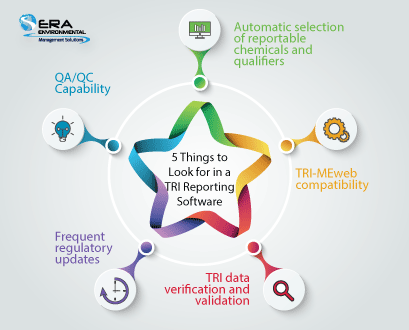TRI reporting is a long and complicated process with an endless list of rules to follow. The EPA’s TRI instruction guide is 172 pages long. Knowing every regulatory requirement and rule that accompanies this environmental report can be a challenging task for EHS experts and would require hours of research. There are many TRI software tools that you can use to automate this process for more effective TRI reporting and to save time from pouring through spreadsheets or hand calculating chemical usages. So, what makes a good TRI software?
When choosing from the available software solutions there  are some essential functions that they need to possess. The best features that indicate that you have found the best Toxic Release Inventory software include:
are some essential functions that they need to possess. The best features that indicate that you have found the best Toxic Release Inventory software include:
- TRI-MEweb compatibility.
- Automatic selection of reportable chemicals and qualifiers.
- Frequent regulatory updates.
- QA/QC Capability.
- TRI data verification and validation.
1. TRI-MEweb Compatibility
Each reporting year, EPA makes changes and improvements to TRI-MEweb. The updates are listed by the EPA to keep you informed.
It is essential to check if your chosen software produces the XML file that is compatible with the upload tool in TRI-MeWeb to ensure full automation for data reporting. Without this option, all data in all Form R sections would need to be entered manually per chemical.
TRI-MEweb compatibility is an imperative function, and this is characterized by the ability to produce the XML file required to upload Form R for all reportable chemicals. An added advantage is if your TRI reporting software has automated Form R population and a validation step that mirrors the TRI-MEweb process.
2. Automatic Selection of Reportable Chemicals and Qualifiers
One best practice that is mentioned by all TRI experts is to keep track of all your chemicals regularly then determine the ones that exceed the TRI reporting threshold when you are ready to start filing your Form Rs. Having a system that can effectively do the threshold calculations for you is vital. Some tools show you a comprehensive list of all your valid TRI chemicals and select the ones that exceed the threshold for you. Your software should be able to help you determine which of your chemicals need to be included and also present the information in a simple way.
For many companies, when they review TRI threshold determinations for a given reporting year, frequently they start from an internal list of SARA 313 chemicals and base all evaluations on that. This can be misleading, however, as certain chemical categories such as Glycol Ethers can contain some reportable chemicals which are not individually listed. To know that you have a comprehensive list of TRI reportable chemicals, you would need to have a chemist review and maintain this list annually.
Additionally, the software you select should incorporate chemical qualifiers and chemical category requirements for a seamless reporting experience. It can be difficult to keep track of requirements and threshold determination calculations needed for metals and metal categories since there is specific guidance from the EPA about how to determine which is reportable. You should be considering these rules for threshold determination and ensure that you consider chemical qualifiers to exclude any chemicals that don’t meet reporting criteria. For example, Zinc is only reportable in fume or dust form, while Zinc Compounds do not have any qualifier. If you have a software solution that can effectively automate this logic with prebuilt determinations, then you can skip the process and focus on evaluating your data to ensure accurate reporting.
These TRI best practices can be automated and are a must-have feature when selecting a reporting tool for your organization.
3. Frequent Regulatory Updates
TRI Regulations for both reportable chemicals and chemical categories change frequently. Each year, the EPA reviews TRI chemicals based on toxicology studies carried out by different organizations. Once toxicity is determined, the EPA then decides on reporting requirements and TRI reporting thresholds. In the 2020 reporting year, five Persistent Bioaccumulative Toxins (PBTs) were added to the toxic chemicals list along with rules surrounding reporting and use. Many changes happen regarding TRI and it is a tedious job to keep up with them. This blog article outlines the importance of constant regulatory updates for environmental reporting.
Your environmental reporting system must be up to date on all regulatory updates and chemical category rules. For example, there could be chemicals added to the list, or chemicals with a lower de minimis concentration in the current report year. These changes can be easy to overlook, which could lead to misreporting or non-reporting of a required chemical. Your selected software should be kept up to date with all published changes to TRI regulations to allow you to redirect research time to more QA/QC activities. If you are confident that you are following the TRI reporting rules, you can spend more focused time and energy analyzing your TRI data effectively.
4. QA/QC Capability for TRI Data
No matter how you are processing your report you need a good QA/QC process. Quality assurance options should be present in your software of choice. Some QA options may include reviewing:
- Details per chemical about which products and usages contribute to threshold determinations and release calculations for air, waste, and water.
- Details per chemical about which waste streams contribute to amounts shipped off-site, as reported in Section 6.2.
- Previous year and current year comparisons.
- Comprehensive checks for all TRI chemicals that are both above and below the threshold.
Based on data compiled and calculated, your software should allow you to see all your TRI data including the reportable chemicals, their thresholds, and the total quantity manufactured, processed, or otherwise used. An important feature is the ability to view the details of the sources and products that contribute to the calculated values for a particular chemical. For example, if there is an abnormally high usage of a chemical, the software should be able to help you pinpoint the source.
Comparing results for previous years’ TRI reports to the current year is important because it allows you to evaluate how your facility’s chemical usage has changed. For example, if the usage seems to be much higher than the previous year, it may be because your supplier changed the product formulation - your system should be able to help you visualize the changes. With frequent supplier information updates, this process will not leave you wondering where the surges in emissions originate. The system must be able to note this for you so that you don’t have to spend time trying to explain the usage changes.
5. TRI Data Verification and Validation
After filling in your TRI data, your software should give you the ability to verify and check your TRI data in a process that mirrors the TRI-MEweb validation process. Some things that you must check for include if you have added activities, uses, and sub-uses in Section 3, or if you have a valid address and RCRA ID for a waste company where your waste is shipped. Having a software solution to validate your data gives you the peace of mind to ensure that you can successfully upload data to TRI-MeWeb. Being able to check this by the push of a button will make your TRI reporting process move more smoothly.
Validation features include checking if all the necessary fields have been filled correctly and if there are any anomalies. This is an essential feature that will ensure that your forms are completed correctly. The validation should be carried out for each reportable chemical. After this process, you will be ready to submit your report to TRI-MEweb.
Why use ERA’s TRI Reporting Software
The features mentioned above in this article are good indicators of a great TRI reporting tool. We can check how ERA’s reporting tool scores on having these features.
How ERA’s tool measures up to the above-mentioned software requirements:
TRI-Meweb compatibility.
Automatic selection of reportable chemicals and qualifiers, following all TRI guidelines
Frequent regulatory updates.
QA/QC tools.
TRI data verification and validation.
ERA’s tool has all the above-mentioned features and more including:
Producing a file that you can readily upload to TRI-MEweb to automatically populate your Form Rs.
Tracking the emissions throughout the year for easier data compilation along with future year projections.
Pre-filling most of the fields in the form including facility addresses based on what is available in the system.
TRI regulation updates and rules are prebuilt into the tool.
ERA’s Master chemical list with built-in regulatory updates for Federal, State, and Global regulations.
If you would like to schedule a free consulting call with a project analyst. Click below.
This Blog was Co-Authored By:




Comments